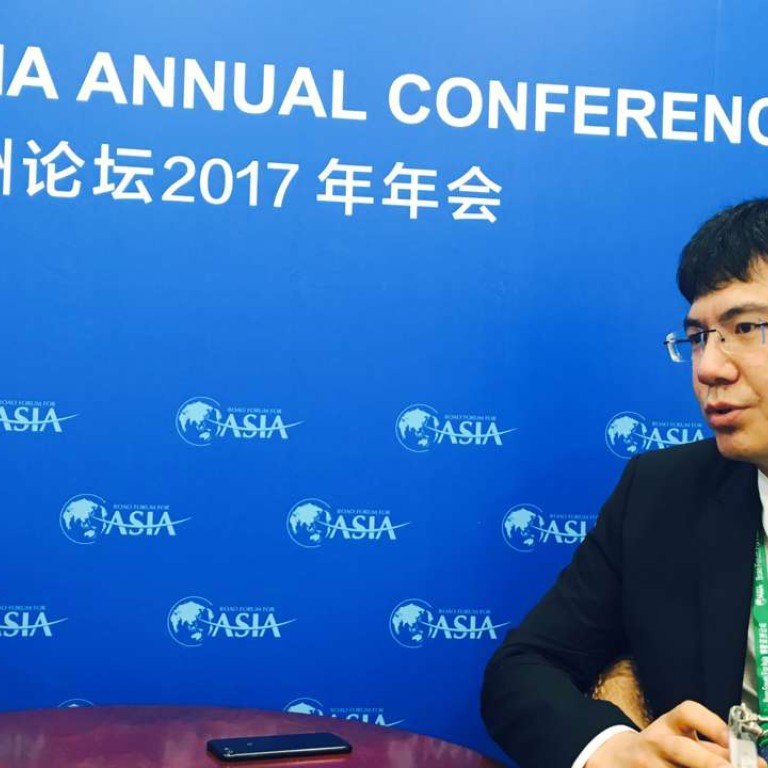
Just a few big Chinese P2P lenders seen surviving in sector tarnished by scandal
Having once enjoyed breakneck growth, China’s P2P lending sector was later rocked by a series of fraud scandals that prompted a government clean-up
The seemingly relentless proliferation of China’s peer-to-peer (P2P) lending platforms has finally been contained by stringent measures introduced by the government in a bid to tackle a fraud epidemic that tarnished the industry’s reputation.
The sector, which ballooned to host thousands of firms of varying sizes and specialities, will eventually become limited to just a handful of mega participants, according to Zhang Shishi, a co-founder of the Chinese P2P platform Renrendai.
“The industry is already healthier,” Zhang said on the sidelines of the Boao Forum for Asia in Hainan province. “The reshuffle among Chinese P2P firms will last for a while, but the market will become highly concentrated – an oligopoly of just a few players – where only companies of large scale will eventually stay.”
P2P lending platforms act as online intermediaries that assist individuals or small businesses in borrowing money from online investors. The internet-based financing method was once seen as a saviour to those – particularly small and medium-sized enterprises (SMEs) – that were unable to obtain loans from traditional financial institutions such as banks.
However, the heated competition that emerged as a wave of profit-hungry new players crowded in, all hunting aggressively for investors and money in the markets, led to a rise in illegal activity. Countless cases of P2P lenders promising high returns from non-existent projects and then running off with the proceeds made the headlines.
The industry is already healthier. The market will become highly concentrated – an oligopoly of just a few players
The most notorious was the Ponzi scheme run by Ezubao, then China’s largest P2P lender, which in late 2015 ripped off some 900,000 investors to the tune of 50 billion yuan.
The government eventually abandoned its hands-off approach to a sector by now battered by scandal and introduced tough new rules.
Announced in August of 2016, the new requirements included the stipulation that P2P lenders elect a qualified banking institution as a fund custodian.
Limitations were introduced on the amount that could be borrowed. Individuals were now allowed to borrow 200,000 yuan from one P2P platform and a maximum of 1 million yuan spread across several lenders.
For enterprises, the amounts were capped at 1 million yuan and 5 million yuan, respectively.
The new rules sent out a clear signal from the regulators that the mainland’s P2P lending platforms should only be supplementary to the banks, and should not be chasing large businesses or investors, said Zhang.
The P2P lenders were given 12 months to comply with the new rules. At the end of last year, 184 P2P platforms – just 8 per cent of the 2,307 that were running without severe financial problems – had launched a fund custody mechanism.
A further 122 companies had signed fund custody agreements with Chinese banks but were yet to adopt them in practice.
But the new rules appear to have stemmed the chaotic expansion of the sector. According to the industry data provider Wangdaizhijia, only five new platforms started operating in January and February of this year.
The average expected returns among Chinese P2P lenders have also been steadily declining. Between January 2016 and February 2017, the average annualised rates among all the platforms in operation fell from 12.18 per cent to 9.51 per cent, according to Wangdaizhijia.
The contracting returns of P2P products are a reflection of both the supply and demand sides. They remain attractive to investors, however, compared to the 4 per cent returns normally seen in the financial products provided by the banks, Zhang said.
Compared with the sky-high returns the on offer in the early days as the lenders competed to attract funds, today’s smaller returns show how investors’ confidence in P2P companies has grown, he added.
Despite its reputation being undermined by the spate of scams, the Chinese P2P industry’s contribution to helping SMEs and individuals raise capital at lower costs should not be overlooked, said Hu Bin, deputy director-general of the Chinese Academy of Social Sciences (CASS).
The government should crack down rigorously on fraudulent platforms, and design policy that supports those platforms that are performing well, he said.
“An early-warning mechanism is crucial in order to monitor the internet finance industry and know where the next risks will come from. It is not just for the P2P sector, but the overall internet-related financial system,” said Hu.

